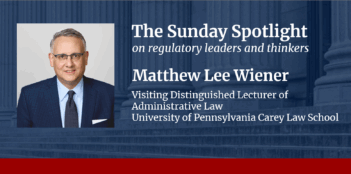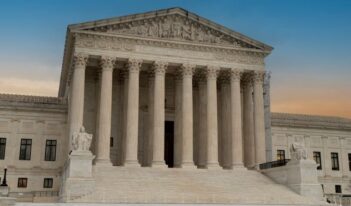
A recent Supreme Court decision could reshape judicial deference of agency actions.
Kisor v. Wilkie, a long-awaited decision from the U.S. Supreme Court’s 2018 Term, begs for comparison to any show about zombies. Dead Man Walking leaps to mind.
The issue in Kisor is how independent or deferential judges’ review of agency decisions that interpret agency rules should be. Similar questions about how much judges should defer to administrative decisions on matters of law or policy have been at the forefront of administrative law for decades.
In 1984, the Supreme Court’s decision in Chevron v. Natural Resources Defense Council seemed to articulate a new test: courts decide if a legal provision central to an agency decision is unclear and, if so, defer to any reasonable agency interpretation of law. Endlessly debated for 35 years, Chevron became the most talked about case in the history of administrative law.
The Supreme Court’s 1997 decision in Auer v. Robbins seemed to follow from Chevron, adopting a similar test for interpretation of agency rules: declaring that if a rule is unclear, courts should defer to any agency reading of it that is not clearly wrong.
No justice dissented in either case, but Chevron was misleading, and Auer was wrong. After the Court’s decision in Kisor, Chevron remains misleading, Auer remains wrong, but the Court took a significant—if muddied—turn by eliminating Auer in all but name and embracing language (in majority and concurring opinions) that could redirect and improve Chevron.
Chevron was misleading because it did not support deference to agency interpretations of the law, although it sounded as if it did. In that case, the question was whether, under the Clean Air Act, the U.S. Environmental Protection Agency (EPA) could treat several smokestacks at a single facility as constituting a “stationary source” of emissions. The Court said “yes,” but plainly saw itself deferring to the agency on a policy choice, not on a question of law. The Court interpreted the law as giving discretion to the agency to make choices consistent with the law. Whether EPA chose to treat several smokestacks as being under a single “bubble” or to regulate their emissions individually was within its discretion as the Court read the law.
Deferring only so far as agencies enjoyed legally delegated discretion is faithful to the history of judicial review prior to Chevron and to the Clean Air Act and Administrative Procedure Act (APA), the latter which commands courts to make decisions on legal interpretation, deferring so far as a law commits implementation to agency discretion. Chevron should be—but is not always—read in that light.
Auer was wrong because it did not simply command deference so far as the law gave an agency discretion. It commanded deference whenever a rule was ambiguous, regardless of whether the rule’s interpretation fell within the agency’s legally committed discretion.
That command is at odds with constitutional grants of different powers to three branches of the federal government: Congress legislates; administrators implement; and courts say what the law means (when necessary to decide cases). Auer’s error was noted by increasing numbers of justices and scholars over the past ten years, not least Auer’s author.
Fast-forward to Kisor. The 5-justice majority in Kisor chose not to formally overrule Auer. But after Kisor, directions for judicial review of agency own-rule interpretation bear scant resemblance to Auer deference.
The Kisor majority condemns the oft-quoted statement from Auer that an agency’s interpretation of its own regulation is “controlling unless ‘plainly erroneous or inconsistent with the regulation’” saying this formulation “may suggest a caricature of the doctrine, in which deference is reflexive.” But that “caricature” was the Auer doctrine. Reflexive deference was Auer’s essential command.
Auer’s doctrine was quoted from Bowles v. Seminole Rock Sand & Gravel. Seminole Rock upheld the application of a wartime price control rule that fit the Court’s reading of the rule, a reading it found compelled to accept based on the rule’s language and its consistent application. It was unnecessary to the decision of Seminole Rock and of Auer. But it was clear.
The Kisor majority declares that judges must “exhaust all the ‘traditional tools’ of statutory construction” before deciding that application of a rule is a matter “more of policy than of law.” The agency construction must be an exercise of lawful policy discretion (an inquiry into “the character and context” of the administrative decision). And it must be a reasonable exercise of discretion that rests on the agency’s expertise, is taken by a suitable official, reflects “a fair and considered judgment” of the agency, and does not cause unfair surprise.
There a lot of considerations needed for deference, none of which were found in the rule ostensibly being upheld.
Four justices speaking through Justice Gorsuch would eliminate Auer, describing the doctrine after Kisor as “maimed and enfeebled—in truth, zombified.” They assert that Auer at its core contradicts the APA. Four justices speaking through Justice Kagan disagree (perhaps because of the doctrine’s surgical alterations in Kisor). Chief Justice John Roberts says the sides are not far apart, eliding comment on Auer’s fit with the APA.
The Court’s view of the APA is not clear. But it is clear that, absent a sharp U-turn, Auer now exists in name only.
The Kisor opinions also point the way to a better Chevron, although not necessarily a single version. Despite explicit and repeated statements that it was not addressing Chevron, Kisor reveals a solid majority supporting approaches incompatible with many statements about Chevron’s meaning.
Justice Kagan’s opinion—stressing the “traditional tools” language of Chevron’s footnote 9, focusing on judge-determined legal bounds around administrative discretion, and emphasizing the distinction between legal interpretation and policy judgments—points toward a return to the vision of Chevron as retaining judicial primacy in interpretation. Once again, the Court understands Chevron deference as proper only within the bounds of legally committed and judicially confirmed agency discretion—contradicting past characterizations of Chevron as deference to agency interpretation of law.
Ultimately, Kisor is largely sensible, though disingenuous. Zombie movies tell us a day of reckoning must come. The question is whether the walking dead attack the living or merely seek a more peaceful repose. Stay tuned.
This essay is part of a series, entitled The Supreme Court’s 2018–2019 Regulatory Term.




